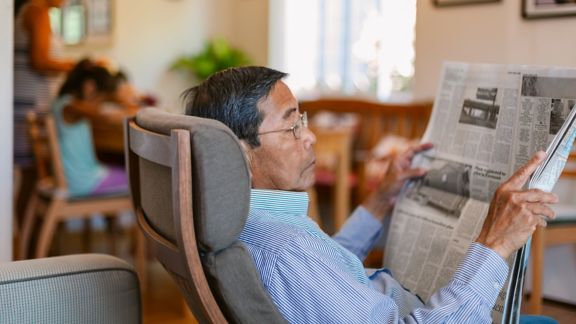Harnessing GIS & Remote Sensing for Precision Sample Frames and Survey Insights
August 2025
In an era defined by complex social and environmental interactions, traditional survey methods alone may overlook critical geographic patterns and localized differences.
NORC’s expertise in geographic information systems (GIS) and remote sensing allows research teams to integrate high-resolution spatial data directly into sample-frame development, survey design, and subsequent research.
By combining up-to-date satellite imagery, detailed land-use classification, and advanced spatial analytics with proven sampling methodologies, we are able to provide richer context for a variety of complex issues, including community health burdens, access to services, and social vulnerability.
This approach not only improves the precision of sample selection but also unlocks powerful, actionable insights—helping policymakers and program designers to target interventions more effectively while elevating the rigor and relevance of survey research.
What is remote sensing?
Remote sensing uses indirect measurement to collect data from a distance, theoretically enabling continuous measurement of conditions on Earth (Hall, 2010; Taubenböck et al., 2009). Sensors, such as those aboard aircraft and satellites, allow analysts to monitor and capture ground conditions over time. Data obtained using remote sensing techniques are often made available in the form of images, which can be processed to support scientific interpretation.
The spatial, temporal, and spectral resolution of images determine the precision with which ground conditions can be determined.
- Spatial resolution determines the level of detail present in the image based on the size of a single pixel and the ground area it corresponds to; higher spatial resolution images improve analysts’ ability to identify ground features.
- Temporal resolution is the time elapsed between images and indicates how often a sensor revisits and observes a location; higher temporal resolution supports change detection by providing more points in time for comparison.
- Spectral resolution indicates the sensor’s ability to differentiate wavelengths of light on the electromagnetic spectrum; imagery can be produced with multiple bands, such as red, green, blue, and infrared, which can be combined to produce enhanced composite images of specific feature types on Earth’s surface, such as vegetation.
What information can remote sensing provide?
Public programs such as NASA and USGS’s Landsat have been capturing images of Earth for over 50 years, providing an archive of data for studying changes to the Earth’s surface. In recent years, data from small satellites, drones, and other unmanned aircraft have also become available, making the prospect of using remotely sensed images in social science research even more feasible. Historical archives of publicly available imagery, such as from the Landsat program, provide a baseline for studies of change over time at broader scales, while other data sources may offer imagery with finer spatial, temporal, or spectral resolution, which can be used to identify specific features on the ground at a point in time.
Integrating remotely sensed images with other kinds of social science data, such as surveys and administrative records, can improve data accuracy, efficiency, and completeness (Fox, 2003; Hall, 2010; Rindfuss and Stern, 1998). For example, using satellite imagery alongside an address-based sample frame can help analysts evaluate and mitigate potential biases by identifying areas where residences or businesses may have been omitted or reviewing addresses that fall outside of urban areas. Linking remotely sensed images with survey responses also enables the exploration of relationships between respondents, their characteristics, and the context in which they live, providing points of comparison that can aid analysis and interpretation (Taubenböck et al., 2009). For example, individual survey responses about personal health can be coupled with data from remotely sensed images that indicate the survey respondent’s distance from sources of pollution, such as factories (Demetillo et al. 2020). Remotely sensed imagery with the appropriate level of resolution can be used to identify features, such as specific types of facilities, and detect environmental changes, such as new construction, flooding, or drought.
How does NORC enhance social science research with remote sensing?
Understanding Settlement Patterns
Remotely sensed images can be used to create or enhance address lists, which in turn inform development and settlement patterns. Images can be used to identify missing addresses from the frame, for example, in newly constructed or demolished buildings (Dini, 2014). Images can also be used to help verify zoning information, such as whether a building is commercial or residential. Researchers also use imagery from night-time lights to approximate areas with human settlements, which can be useful in areas where little to no other information about economic activity, urban development, or population areas is available, or as points of comparison with other published data (Sutton et al., 2001).
NORC uses satellite imagery to enhance sampling and address frames across a variety of client projects. For the NORC National Sampling Frame, NORC built an interactive mapping dashboard that linked satellite imagery, building footprint data derived from remote sensing techniques, and county tax parcel data to enhance residential address lists maintained by the United States Postal Service (Fiorio, 2023, Fiorio, 2025). Using this dashboard, in-office listers could identify and add missing addresses, thereby improving address-based sampling (ABS) coverage. NORC also used remote sensing to create enumeration areas for a survey of businesses in Greater Accra, Ghana for the Ghana MiDA Household and Enterprise Survey. NORC split the study area into districts with roughly equal counts of businesses for use during field work by leveraging open-source Visible Infrared Imaging Radiometer Suite (VIIRS) night-time light data to estimate business counts and road network data from OpenStreetMap to ensure that the enumeration areas had identifiable borders and compact shapes. For the Maternal and Child Health Jurisdictional Survey (MCH-JS) in the Federated States of Micronesia, satellite data was used to build a high-resolution matrix where each cell contained a count of households. The household grid cells were grouped to form enumeration areas with sizes and shapes designed to account for natural geography and ease interviewer burden when conducting random walks of the enumeration area to select households.
Geospatial satellite imagery can be used to construct enumeration areas and provide field teams with data in the absence of other high-quality information to develop or validate sample frames. Images, or derived information like land use and land cover, adds valuable context to address frames, which can be used for further stratification and analysis. In the absence of official statistics or other updated data sources, imagery can also be used to produce population estimates that reflect current conditions, especially for areas experiencing rapid growth.
Measuring Environmental Exposure
Incorporating environmental factors, such as vegetation growth, changes in forest cover, or local agricultural conditions into health studies can provide valuable insights into the relationship between the environment and health outcomes (Grace et al., 2013; Johnson et al., 2013). For example, Johnson et al. (2013) combined remotely sensed imagery on the forest cover in Malawi and Health Survey (DHS) data to examine the relationship between deforestation, poor dietary diversity, and child malnutrition. Similarly, Grace et al. (2013) employed remotely sensed data on vegetation growth alongside local maize price data to assess food availability and its relationship with the birth weights of infants in Kenya.
NORC uses remotely sensed imagery alongside other remotely sensed data, such as measurements from senor arrays, to provide near real-time insights into environmental exposures, enabling the development of detailed models. Using spatial interpolation techniques, NORC has linked air pollutant data collected by environmental sensors throughout the City of Chicago to GPS data from the participants in the Chicago Health and Activity in Real-Time project. In this analysis, NORC found that exposure to air pollutants in daily activity spaces contributed to respiratory- and dementia-related diseases at fine scales (English et al. 2022). For the National Social Life, Health, and Aging project and the National Children’s Study, NORC linked environmental data related to air pollution, water quality, and land-cover to longitudinal survey respondents. Using a GIS technique called adaptive bandwidth kernel density estimation, NORC produced tobacco retailer density grids for the Truth Foundation. These density grids were extracted to Census geographies to first measure associations between neighborhood sociodemographic factors and retail density and then link retail density measures to survey respondents.
Understanding the spatial distribution of environmental burdens, as well as access to critical care services, can provide more insights into health outcomes and help identify areas with high social vulnerability or resilience. Policymakers and community advocates can also use this information to develop spatially targeted interventions or strategies to help mitigate burdens or improve access to services and care. Integrating remotely sensed data into projects with survey data enriches responses and enables context-rich spatial modeling.
Conclusion
Remotely sensed imagery supports a variety of social science applications at NORC, with prospects for further development. Remotely sensed data has the potential to improve data collection, enhance data quality, and enrich insights into conditions on the ground in near-real time. Integrating remotely sensed imagery into social science research supports a wide variety of tasks, from address frame construction and enhancement to health research. Spatial modeling with remotely sensed data can advance social science research by linking outcomes observed in administrative and survey data (e.g., households experiencing food insecurity) to environmental factors (e.g., zoning), providing missing context and opening new lines of research inquiry.
References
Demetillo, M. A. G., Navarro, A., Knowles, K. K., Fields, K. P., Geddes, J. A., Nowlan, C. R., Janz, S. J., Judd, L. M., Al-Saadi, J., Sun, K., McDonald, B. C., Diskin, G. S. & Pusede, S. E. (2020). Observing Nitrogen Dioxide Air Pollution Inequality Using High-Spatial-Resolution Remote Sensing Measurements in Houston, Texas. Environmental Science & Technology, 54(16), 9882–9895.
Crompton, H. & Burke, D. (2023). Artificial intelligence in higher education: the state of the field. International Journal of Educational Technology in Higher Education, 20(1), 22.
Nagaraj, B., Kalaivani, A., SB, R., Akila, S., Sachdev, H. K. & SK, N. (2023). The Emerging Role of Artificial Intelligence in STEM Higher Education: A Critical review. International Research Journal of Multidisciplinary Technovation, 5(5), 1-19.
English, N., Zhao, C., Brown, K. L., Catlett, C. & Cagney, K. (2022). Making Sense of Sensor Data: How Local Environmental Conditions Add Value to Social Science Research. Social Science Computer Review, 40(1), 179-194.
Fiorio, L. (2025, May 19). How NORC Developed a More Accurate & Affordable Survey Sampling Method Using Satellite Imagery. Retrieved from www.norc.org.
Fiorio, L. (2023). “Accurately Identifying and Enumerating Multiunit Housing with Remote Sensing Data for Address Frame Enhancement” Federal Committee on Statistical Methodology Conference. Washington, DC, October 2023.
Fox, J. (2003). People and the Environment Approaches for Linking Household and Community Surveys to Remote Sensing and GIS.
Grace, K., Brown, M. & McNally, A. (2014). Examining the link between food prices and food insecurity: A multi-level analysis of maize price and birthweight in Kenya. Food Policy, 46, 56–65.
Hall, O. (2010). Remote Sensing in Social Science Research. The Open Remote Sensing Journal, 3(1), 1–16.
Johnson, K.B., Jacob, A. & Brown, M. (2013). Forest cover associated with improved child health and nutrition: evidence from the Malawi Demographic and Health Survey and satellite data. Global Health, Science and Practice, 1, 237 - 248.
Rindfuss, R. R. & Stern, P. C. (1998). Linking Remote Sensing and Social Science: The Need and the Challenges. In People and Pixels: Linking Remote Sensing and Social Science. National Academies Press.
Sutton, P., Roberts, D., Elvidge, C. & Baugh, K. (2001). Census from Heaven: An estimate of the global human population using night-time satellite imagery. International Journal of Remote Sensing, 22(16), 3061–3076.
Taubenböck, H., Wurm, M., Setiadi, N., Gebert, N., Roth, A., Strunz, G., Birkmann, J. & Dech, S. (2009). Integrating Remote Sensing and Social Science - The correlation of urban morphology with socioeconomic parameters. Urban Remote Sensing Joint Event, 1–7.
Suggested Citation
English, N., McRoy, M., Herman, P., Lafia, S. & Vivas Bastidas, J. (2025, August 14). Harnessing GIS & Remote Sensing for Precision Sample Frames and Survey Insight. NORC at the University of Chicago. Retrieved from www.norc.org.






